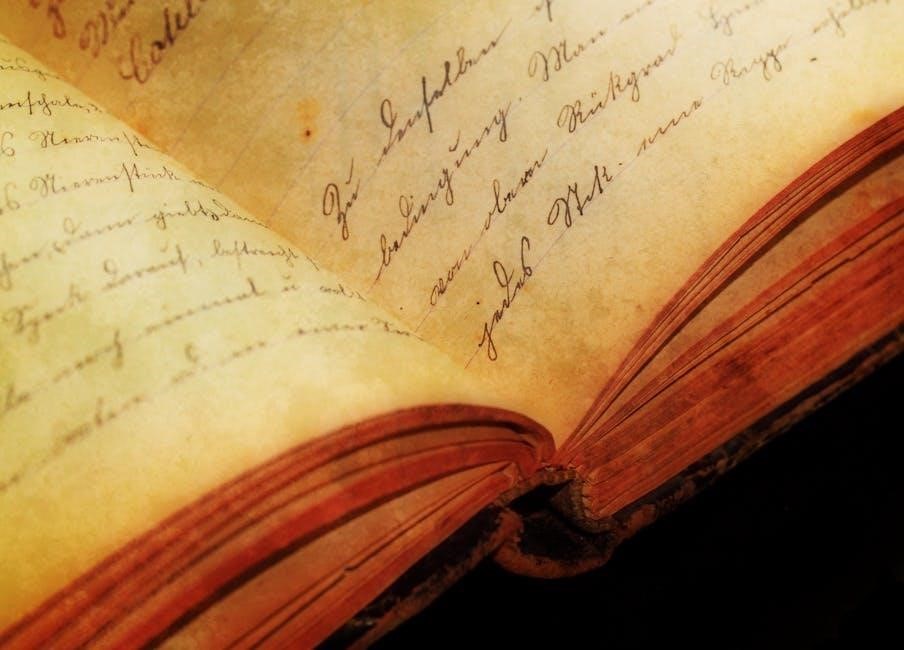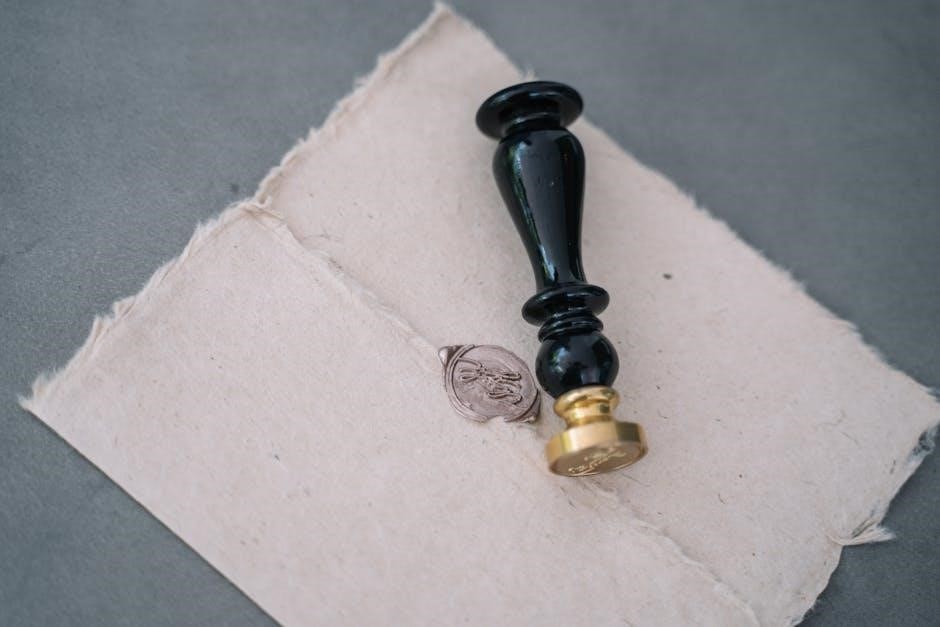Writing in history allows us to explore the past‚ understand the present‚ and shape the future through storytelling and evidence-based narratives.
Understanding the Importance of Historical Writing
Historical writing is essential for preserving the past‚ shaping our understanding of the present‚ and informing the future. It allows us to learn from past events‚ analyze patterns‚ and draw meaningful conclusions. By documenting history‚ writers ensure that collective memory is not lost‚ fostering empathy and insight into diverse perspectives. Historical writing also promotes critical thinking and the development of well-supported arguments‚ making it a cornerstone of academic and cultural discourse. Its value lies in its ability to connect generations and inspire informed decision-making.
Key Principles of Effective Historical Writing
Effective historical writing relies on accuracy‚ objectivity‚ and clarity. It demands a thorough understanding of sources and context to avoid misinterpretation. Historians must present balanced perspectives‚ acknowledging diverse viewpoints while maintaining neutrality. Clear and concise language ensures accessibility‚ making complex ideas understandable. Proper citation and referencing are crucial to maintain credibility and avoid plagiarism. Additionally‚ historians should focus on thematic coherence‚ linking events to broader trends and significance. By adhering to these principles‚ historical writing becomes a powerful tool for educating and engaging readers about the past.

Researching for Historical Writing
Researching for historical writing involves identifying reliable sources‚ conducting thorough analysis‚ and organizing information effectively to build a credible and well-supported narrative.
Identifying Reliable Sources
Identifying reliable sources is crucial for credible historical writing. Prioritize academic journals‚ primary documents‚ and reputable publications. Use databases like JSTOR for peer-reviewed articles. Verify publication dates to ensure relevance and accuracy. Check for peer reviews and author credentials. Cross-reference information with established historical texts to confirm accuracy. Avoid unverified online sources and biased materials. Consult archives‚ libraries‚ and scholarly editions for primary sources. Evaluate the purpose and audience of each source to assess its reliability. This rigorous approach ensures your research is well-founded and trustworthy‚ enhancing the credibility of your historical narrative.
Conducting a Literature Review
Conducting a literature review involves critically analyzing and synthesizing existing research to identify key themes‚ debates‚ and gaps in your historical topic. Start by defining your research parameters and selecting relevant sources. Read and annotate scholarly articles‚ books‚ and primary documents to understand different perspectives. Organize your findings thematically or chronologically to reveal patterns and inconsistencies. Identify areas where further exploration is needed and assess the strengths and limitations of existing studies. This process helps you situate your research within broader historical contexts and informs the development of your argument or thesis.
Effective Note-Taking Strategies
Effective note-taking is crucial for historical research‚ enabling you to capture key ideas and details efficiently. Start with active reading‚ highlighting and underlining important passages. Record summaries of arguments‚ evidence‚ and conclusions in your own words. Categorize information by themes‚ events‚ or sources to organize your thoughts. Use symbols or abbreviations to streamline your notes and ensure clarity. Regularly review and refine your notes to identify patterns‚ gaps‚ or areas needing further exploration. This systematic approach ensures your notes are comprehensive‚ accurate‚ and readily usable for writing your historical analysis or essay.

Organizing Your Article
Organizing your article involves structuring it logically‚ with a clear introduction‚ body‚ and conclusion. Use headings and subheadings to guide readers through your historical narrative or argument.
Crafting a Compelling Title
A strong title is essential for engaging readers and conveying your article’s focus. It should be concise‚ clear‚ and reflective of the content. Use action verbs or questions to spark curiosity. Avoid jargon and ensure clarity. A good title should accurately summarize the main theme or argument of your historical writing. It should also be unique and memorable‚ helping your work stand out. Consider your audience and the context of your topic. A well-crafted title not only attracts readers but also sets the tone for your narrative or argument‚ guiding their expectations and understanding of your work.
A well-structured essay is crucial for historical writing. The introduction should provide context‚ present a clear thesis‚ and engage the reader. The body paragraphs must support the thesis with evidence‚ analysis‚ and logical flow. Each paragraph should focus on a single idea‚ using historical examples and sources to build credibility. The conclusion should summarize key points‚ restate the thesis‚ and offer a final perspective or reflection. This structure ensures clarity‚ coherence‚ and a persuasive argument‚ making your historical narrative or analysis impactful and accessible to your audience.
Creating an Outline for Clarity
Creating an outline is essential for organizing your historical writing. Start with a clear thesis statement‚ then divide your essay into main sections and subsections. Use Roman numerals for primary sections and bullet points for subpoints. Ensure each section aligns with your thesis and supports the overall narrative. Outlining helps maintain logical flow‚ prevents tangents‚ and saves time during the writing process. A detailed outline also makes it easier to revise and refine your work‚ ensuring your arguments are presented clearly and coherently. This step is crucial for producing a structured and focused historical essay.

Writing Style in Historical Contexts
Historical writing demands clarity‚ precision‚ and objectivity. Use evidence to support arguments‚ maintain a formal tone‚ and avoid modern biases. Precision and context are key to credibility.
Writing with Clarity and Precision
Clear and precise writing is essential in historical contexts to convey ideas accurately. Avoid overly complex language or jargon that might confuse readers. Instead‚ use straightforward sentences and specific details to present historical events or arguments. Clarity ensures that your narrative is accessible and engaging‚ while precision guarantees that your facts are accurate and reliable. Always define terms and provide context when necessary; Evidence-based narratives should be concise‚ avoiding unnecessary elaboration. By writing with clarity and precision‚ you ensure your historical work is both credible and impactful‚ making it easier for readers to understand and connect with the past.
Maintaining Objectivity and Bias Awareness
Maintaining objectivity is crucial in historical writing to ensure credibility and fairness. Historians must present balanced perspectives‚ avoiding personal biases or agendas. Recognize and acknowledge potential biases in sources‚ as well as your own‚ to interpret events impartially. Critical analysis of primary and secondary sources helps identify skewed narratives. Present evidence objectively‚ allowing readers to form their own conclusions. Avoid projecting modern values onto historical contexts. By staying neutral and transparent‚ you foster trust in your work. Objectivity strengthens the validity of your arguments and ensures a truthful representation of the past.
Using Evidence to Support Arguments
Using evidence is fundamental to credible historical writing. Primary and secondary sources provide the foundation for your arguments‚ ensuring they are grounded in fact. Always cite reliable sources to support your claims‚ enabling readers to trace your reasoning. Properly contextualize evidence to avoid misinterpretation. Avoid cherry-picking data; present a balanced view. Integrate evidence seamlessly into your narrative to maintain flow. Without evidence‚ arguments lack authority and credibility. Ensure all sources are accurately referenced to maintain academic integrity and avoid plagiarism. Evidence-based writing builds trust and strengthens the persuasiveness of your historical analysis.

Revising and Editing
Revising and editing are crucial steps in refining your historical writing. Review your draft for coherence‚ clarity‚ and accuracy. Edit for grammar‚ style‚ and tone to enhance readability and ensure your arguments are effectively communicated.
Reviewing Your Draft for Coherence
Reviewing your draft for coherence ensures your historical narrative flows logically and maintains clarity. Start by reading your draft aloud to identify awkward phrasing or disjointed ideas. Ensure each paragraph transitions smoothly to the next‚ using clear topic sentences that guide the reader. Check that supporting evidence aligns with your thesis and that each section builds upon the previous one. Eliminate redundant information and tighten language for precision. Finally‚ verify consistency in tone‚ style‚ and terminology throughout the document to create a polished‚ unified narrative.
Editing for Grammar and Style
Editing for grammar and style is crucial for producing polished historical writing. Begin by checking for grammatical errors‚ ensuring subject-verb agreement‚ and proper punctuation. Vary sentence structure to enhance readability and maintain the reader’s interest. Use active voice to convey ideas clearly and avoid unnecessary jargon. Ensure consistency in terminology‚ formatting‚ and citations throughout the document. Finally‚ proofread meticulously to eliminate typos and awkward phrasing‚ ensuring your writing is professional and engaging. Utilize grammar checkers and style guides to refine your work and maintain historical accuracy and clarity.

Understanding Your Audience
Understanding your audience helps tailor your writing to their needs‚ ensuring clarity and relevance. Consider their expertise‚ interests‚ and expectations to craft engaging‚ accessible content.
Identifying Your Target Audience
Identifying your target audience is crucial for effective historical writing. Consider their expertise‚ interests‚ and expectations to tailor your content. Are they scholars‚ students‚ or general readers? Academic audiences may expect detailed analysis and citations‚ while general readers prefer accessible‚ engaging narratives. Understanding their background helps you adjust language‚ depth‚ and examples. Tailor your tone to match their familiarity with historical terminology. This focus ensures your writing resonates and provides value‚ whether it’s for academic discourse or public education. Clarifying your audience early guides your research‚ structure‚ and style decisions.
Tailoring Your Language and Tone
Tailoring your language and tone ensures your historical writing resonates with your audience. Define your audience first—are they scholars‚ students‚ or general readers? Adjust your vocabulary and complexity accordingly. Use clear‚ concise language to make history accessible without oversimplifying. Maintain a formal tone for academic contexts‚ while engaging narratives can captivate broader audiences. Avoid modern jargon when discussing past events to preserve authenticity. Balance depth with readability‚ ensuring your writing is both informative and absorbing. This approach ensures your work is respected by experts and appreciated by casual readers‚ bridging the gap between academia and public understanding.

Time Management and Deadlines
Effective time management is crucial for historical writing; Set realistic goals‚ prioritize research‚ outline‚ and draft. Stay organized to meet deadlines and produce quality work.
Creating a Writing Schedule
A well-structured writing schedule is essential for historical writing. Break your project into manageable tasks‚ allocate specific time blocks for research‚ outlining‚ and drafting. Set realistic deadlines for each stage to maintain progress. Prioritize tasks based on importance and complexity‚ ensuring a logical flow. Dedicate time for revision and editing to refine your work. Use calendars or apps to track deadlines and stay organized. Consistency is key—commit to regular writing sessions to avoid procrastination; A structured schedule helps maintain focus and ensures high-quality‚ timely completion of your historical writing project.
Avoiding Procrastination
Avoiding procrastination is crucial for successful historical writing. Break tasks into smaller‚ manageable steps to reduce overwhelm. Set clear‚ achievable deadlines and maintain a consistent writing routine. Start with the simplest tasks to build momentum. Use time-management tools like calendars or apps to track progress. Eliminate distractions by creating a focused workspace. Remind yourself of the importance of your work to stay motivated. Procrastination delays progress‚ so commit to taking action daily. By staying disciplined and organized‚ you can overcome procrastination and ensure timely completion of your historical writing project.

Resources for Further Learning
Explore essential books like “The Elements of Style” and online tools such as JSTOR and Google Scholar for in-depth historical research and writing guidance.
Recommended Books on Historical Writing
For a deeper understanding of historical writing‚ explore essential texts like “The Elements of Style” by William Strunk Jr. and E.B. White‚ which offers timeless writing guidance. “A Historian’s Guide to Writing” by Richard A. Marius provides practical advice on structuring historical narratives. Additionally‚ “The Historian’s Craft” by Marc Bloch is a seminal work on historical methodology. These books‚ along with online resources like JSTOR and Google Scholar‚ will enhance your writing skills and research techniques‚ ensuring well-supported and engaging historical narratives.
Online Tools for Researchers
Utilize online tools like JSTOR and Google Scholar for accessing academic articles and primary sources. Zotero and EndNote help organize references and citations efficiently. Grammarly ensures error-free writing‚ while Hemingway Editor improves clarity. Online archives such as the Internet Archive and HathiTrust provide valuable historical documents. SEO tools like Google Keyword Planner can enhance article visibility. These resources streamline research‚ writing‚ and publication processes‚ making historical writing more accessible and effective for scholars and enthusiasts alike. They are indispensable for producing well-researched‚ polished‚ and impactful historical narratives.
Mastering historical writing requires dedication‚ research‚ and clarity. Use evidence to craft compelling narratives‚ stay objective‚ and engage your audience effectively. Success lies in precise storytelling.
Final Tips for Success in Historical Writing
To excel in historical writing‚ prioritize clarity‚ accuracy‚ and engagement. Craft compelling titles that reflect your thesis‚ and maintain objectivity by presenting balanced perspectives. Use primary sources to strengthen arguments and avoid anachronisms. Ensure your narrative flows logically‚ connecting past events to their significance; Stay disciplined with deadlines and seek feedback to refine your work. Engage your audience by making history relatable without sacrificing academic rigor. Lastly‚ continuously refine your writing skills and stay curious about diverse historical perspectives to produce meaningful and impactful narratives.



